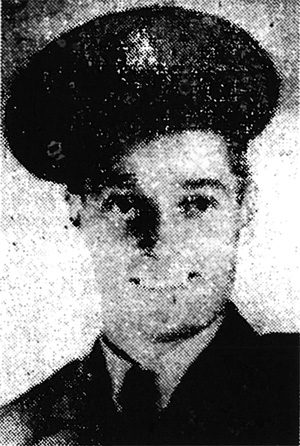

Remember...
Clyde A. McClung
1917-1944
"In War: Resolution. In Defeat: Defiance. In Victory: Magnanimity. In Peace: Good Will."
Winston Churchill
 |
Remember...Clyde A. McClung
|
Clyde McClung was born on April 21, 1917, to Augustus ("Gus") and Susan Arbaugh McClung. They lived in Canvas, Nicholas County, West Virginia. The 1920 Federal Census indicates that Mr. McClung was a laborer in a lumber yard. The McClungs had three sons: Orvall, Clyde, and Lester. The 1930 census indicates that the family had grown in the preceding decade. They were joined by Audrey, Virginia, and Emma (shown as Emogene in other documents). Mr. McClung was then a farmer, and the older boys were laborers. The 1940 census taker recorded a new son, Flavia, and the family was engaged in farming, as in 1930.
Clyde McClung registered for military service on October 16, 1940, with the Nicholas County Selective Service Board. At the time of registration, he was unemployed. On June 18, 1942, he enlisted in the U.S. Army, a 5'10" young man with brown hair and brown eyes and a light complexion. He'd finished grammar school and no more, and was a mail carrier, with no dependents. He was unmarried.
No record was found that shows with certainty when Private First Class Clyde McClung was placed with Company H of the 6th Armored Infantry Regiment, but if he was with them for his whole service, he can be assumed to have staged with the Regiment at Fort Dix, New Jersey, in April 1942; left for Ireland on May 31 from the Port of New York; and arrived overseas in June. If with them then, he landed in North Africa in December and then on to Italy in October 1943. ("6th Infantry Regiment (United States)," Wikipedia, 20 September 2019, accessed 27 October 2019, https://en.wikipedia.org/wiki/6th_Infantry_Regiment_(United_States).) The regiment, within the 1st Armored Division, was part of the effort known as the Italian Campaign. The goal was to defeat Italian Axis forces and draw German troops away from northern Europe. The campaign lasted from July 10, 1943, to May 2, 1945, and encompassed beach landings and land battles from southern Italy up the mainland. According to one source, "The Allied advance through Italy produced some of the most bitter, costly fighting of the war, much of it in treacherous mountain terrain." (History.com Editors, "Italian Campaign," History, 18 November 2009, accessed 27 October 2019, https://www.history.com/topics/world-war-ii/italian-campaign.)
Gordon Rottman, in his book World War II U.S. Armored Infantry Tactics, writes of the importance of an armored infantry:
Their contribution to the war effort was hugely important. There were a total of 57 armored infantry battalions and two regiments that served throughout the war and in all theaters. Equipped with halftracks, they fought as part of combined arms teams and combat commands alongside tanks, tank destroyers and artillery battalions. Significantly, they were not simply standard infantry battalions provided with halftracks. Their company and platoon organization was very different from the standard infantry unit and these highly mobile, heavily armed battalions fought in an entirely different manner.
No evidence was found to indicate Clyde McClung's role in H Company, but if he remained with the 6th Armored Infantry Regiment, he would have been part of the push from Anzio to Rome. These battles and mountain fighting were detailed in several books, but one is focused on the experiences of the men of the 6th Armored Regiment. From Anzio to the Alps, by Lloyd M. Wells, gives a first-person account of the savage fighting in central Italy. The headline of the campaign was the eventual arrival in Rome on June 4, 1944, a couple of days ahead of D-Day in Normandy, which drew attention and troops to support the invasion. The Italian campaign delivered on few of its goals, having gotten off to a slow start bogged down on the beachhead, understaffed for its aggressive goals, and overwhelmed by weather and failures of command, including disregarded orders that allowed enemy troops to escape that went on to fuel the war in other places. Rome was vacated by the time the Allies reached it. (History.com Editors, "Italian Campaign," History, 18 November 2009, accessed 27 October 2019, https://www.history.com/topics/world-war-ii/italian-campaign.) However, the troops' presence in Italy pressured the Axis to respond to the threat. There were hundreds of thousands of casualties on both sides, with tens of thousands of deaths.
What is not written about as much is the continued fighting after the milestone of Rome was reached. The Allies continued the push north. Over a month after reaching Rome, Clyde McClung was killed in action, somewhere on the route. No records were uncovered that state where Clyde McClung met his fate, other than he was killed in action in Italy.
Only two weeks later, the 6th Armored Infantry Regiment was disbanded and remade into other units.
Article prepared by Cynthia Mullens
October 2019

West Virginia Archives and History welcomes any additional information that can be provided about these veterans, including photographs, family names, letters and other relevant personal history.